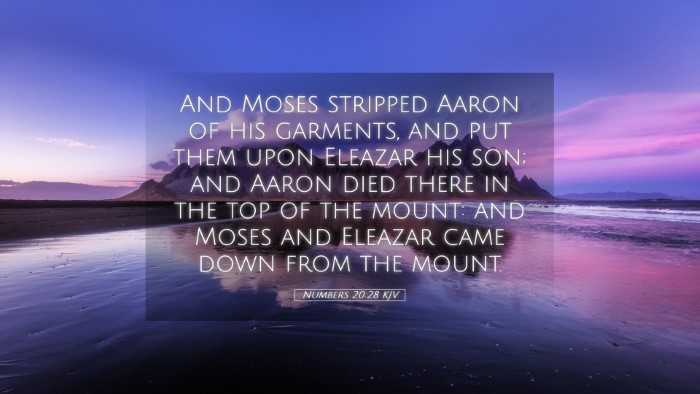Commentary on Numbers 20:28
Numbers 20:28 states: "And Moses stripped Aaron of his garments, and put them upon Eleazar his son; and Aaron died there in the top of the mount: and Moses and Eleazar came down from the mount."
Context and Background
This passage occurs in a significant moment in Israelite history, marking the transition of priesthood from Aaron to his son Eleazar. It encapsulates not only the physical death of Aaron but also the spiritual importance of maintaining God's appointed order among His people.
Commentary Insights
Aaron's Stripping of Garments
According to Matthew Henry, the act of stripping Aaron of his garments symbolized the transfer of the high priestly authority. The garments, which were sacred and symbolized his role as the mediator between God and the people, were not merely clothing but embodied his spiritual and social responsibilities.
Albert Barnes emphasizes that this transfer was solemn and marked by obedience to divine command. The garments themselves also had significant meanings attributed to them in the worship practices of Israel, representing their covenant relationship with God. The ceremonial importance of transferring the garments cannot be understated, as it ensured that the ministry continued without disruption.
The Death of Aaron
Adam Clarke highlights that Aaron’s death was a profound loss for Israel. As the first high priest, Aaron had held a pivotal role in leading the people spiritually. His death at Mount Hor was in accordance with God’s command; it underlined God’s judgment on disobedience, as Aaron, alongside Moses, had failed to honor God at Meribah.
In this pivotal moment, the mountain symbolizes both a physical and spiritual elevation. It is a reminder of God's presence and holiness, juxtaposed with the frailty of human leadership.
The Role of Eleazar
The elevation of Eleazar serves as a reminder of continuity in God’s plans. Henry notes that Eleazar was chosen to take up this important responsibility, a decision that reflects God’s ongoing commitment to His covenant with Israel despite the backdrop of human failure. This generational succession reinforces the importance of passing down spiritual leadership and the sacred duties involved.
Barnes points out the significance of Eleazar’s position as it indicates a new phase in Israel's journey. As they continued towards the Promised Land, maintaining the integrity of their worship and leadership was crucial. Eleazar would lead the people in worship and sacrificial practices that would define their identity as God’s chosen people.
The Coming Down from the Mountain
The journey back down from the mount represents a returning to the everyday realities of life after experiencing a significant spiritual event. Clarke notes this serves as a reminder that leaders must integrate their spiritual experiences into their daily responsibilities. Moses and Eleazar returning to the camp not only denotes the end of a significant personal moment but also an essential shift in the community's leadership structure.
This continuation was critical. The people needed clear leadership as they faced approaching challenges. The transition also illustrates that while one era may end, another begins filled with potential for growth and renewal.
Theological Implications
This passage provokes deeper theological reflection concerning the nature of leadership and transition within God's community. Henry posits that God is sovereign over life and death; His purposes prevail even as leaders pass away. In light of this, church leaders today can derive comfort knowing that God's hand orchestrates transitions.
Moreover, it invites the faithful to consider the legacy of their own leadership. What garments are they passing down spiritually? Are they equipping the next generation of leaders with the correct understanding of what it means to serve God and His people?
Conclusion
Numbers 20:28 encapsulates a poignant moment in biblical history, reflecting God's ongoing work in His people. As Moses strips Aaron of his garments and bestows them on Eleazar, we see themes of authority, obedience, leadership transition, and the importance of continuity in spiritual practices. For pastors, students, and theologians, this passage serves as a reminder of the sacred duty of leadership in the community of faith, urging them to reflect on their role in God's redemptive history.


